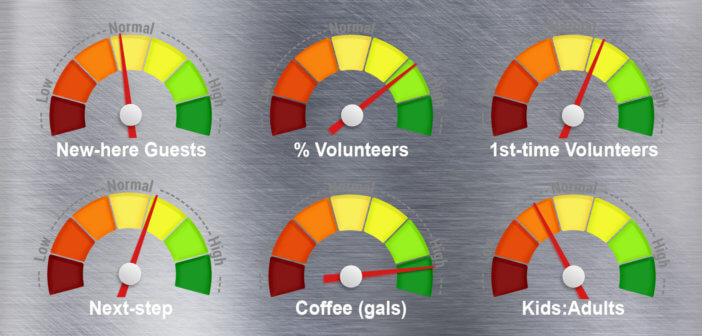Worship attendance and revenue figures don’t tell the whole story in gauging your church’s effectiveness. Rich Birch suggests some novel indicators that can reveal growth and engagement — from how many gallons of coffee are consumed weekly to the ratio of kids to adults.
Too often, church leaders only pay attention to weekend attendance and revenue patterns at their churches. However, there are many other factors to consider if we’re trying to understand what’s really happening. Attendance and revenue numbers are limited indicators; they are simply the result of other things taking place. To have a true understanding of how our churches are growing, we need to dive into leading indicators.
Leading indicators are numbers that demonstrate what’s happening under the hood and reveal the direction a church is heading. We measure and study those numbers because we believe that if we focus on measuring them, we will see a greater difference in the lives of the people in our church and in the community that we serve. If we consistently report only attendance and revenue numbers, then we send a subtle message that the only thing we care about are bigger numbers and more money.
Here are six other areas that you can regularly study to help you understand what’s taking place in your ministry.
1. New-here guests
Understanding the ratio of new-here guests to total average attendance can provide a clearer picture of what’s happening from an evangelistic perspective. This important indicator demonstrates whether the church is drawing in new people on a regular basis. A good rule is: the number of new-here guests per year should be equal to the average number of attendees per Sunday. If 200 people, on average, attend your church each week, then you should be averaging about four guests a week to total about 200 for the year. If your church typically has too few guests to yield that ratio, it could be that your front door simply isn’t wide enough and that you need to spend more time reaching out to your community.
2. Percentage of volunteers
This is an important health metric for the church. Oftentimes, churches that have plateaued or are in decline see somewhere around 20% of their people serving on a regular basis. You’ve heard the adage that 20% of the people do 80% of the work. Well, that’s not a good percentage ratio for your church. Engagement is critically important to a growing church, and people serving regularly is a crucial factor that ensures engagement. I’ve seen in growing churches that on any given weekend, 30% of the adults are volunteering in one way or another. Let’s do the math. If your church had 300 people in attendance last weekend, it would be reasonable and appropriate to see 100 people serving next weekend. That number of volunteers provides a high level of service for your guests. The volunteer percentage is a critically important piece of the puzzle to understand what’s happening in your church.
3. First-time volunteers
An even more granular number is the inflow of volunteers that serve on a regular basis. If you are not seeing a consistent increase in the number of people volunteering, it is clear something is happening to stunt engagement and the future health of your church. If your volunteer influx reaches zero, you have a pipeline problem. You will not necessarily feel the pain today but certainly will in six months to a year. Ask yourself this question: how many first-time volunteers have you had in the past month?
4. Next-steps indicators
Are people responding to what’s happening in the life of your church? Is there tangible evidence that the ministry is making a difference in people’s lives? Are people taking steps closer to Jesus? Where can you see new spiritual development? Are people signing up for classes? Finding a way to track next-steps indicators is an important way to examine the softer side of our ministry. If these numbers atrophy, it’s an indicator that you need to change and adjust what you’re doing.
5. Gallons of coffee
This one’s a little bit tongue in cheek, but I do think there’s something important about trying to quantify and track community that’s taking place at your church. If people aren’t taking the time to interact with one another, it indicates a larger community problem. While I understand that gathering in small groups develops a greater sense of community than a Sunday morning gathering, we don’t want our Sunday mornings to feel like a show. We don’t want people to arrive and feel so rushed to leave that they can’t slow down, grab a coffee, and talk with members of their church family. So, while gallons of coffee may seem like a funny metric to keep an eye on, the question I would have for you is what are some other ways that you could quantify community happening within your church on a Sunday morning?
6. Kids-to-adults ratio
Looking at the broader impact of your church, you need to consider how you’re reaching the next generation. Churches that are impacting their community are obsessed with reaching the next generation. They spend a lot of time, effort, and energy on reaching young people and getting them connected to the church. They spend resources to ensure these ministries are led and funded well. One commonality among churches in the final gasps of death is that there are no kids left in the church. Keeping a close eye on this ratio over time will give you a sense of the long-term trajectory of your church.
Why tracking matters
Looking just at “nickels and noses” gives you a flat indication of what’s happening in the life of your church. Taking a step back and looking at these other indicators gives you a fuller picture of what’s happening. It’s the difference between a black and white picture and a 3D image. Tracking numbers is ultimately about getting a clear picture of what God is doing in the lives of people in your community.
This article is adapted from a post that appeared on Rich Birch’s blog, unSeminary, and used by permission.
Related Resources
- Overflow: Increase Worship Attendance & Bear More Fruit by Lovett H. Weems, Jr. And Tom Berlin
- Congregational Attendance Profile (CAP) Video Tool Kit
- Measuring Church Numerical Growth is Not as Easy as it Seems by George Bullard






